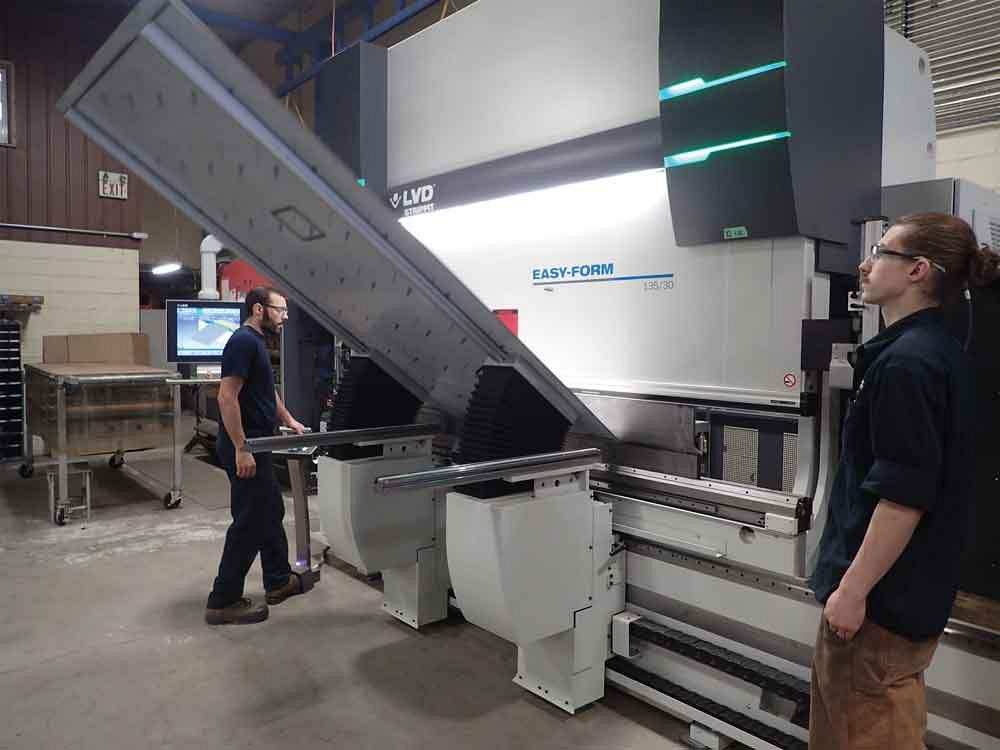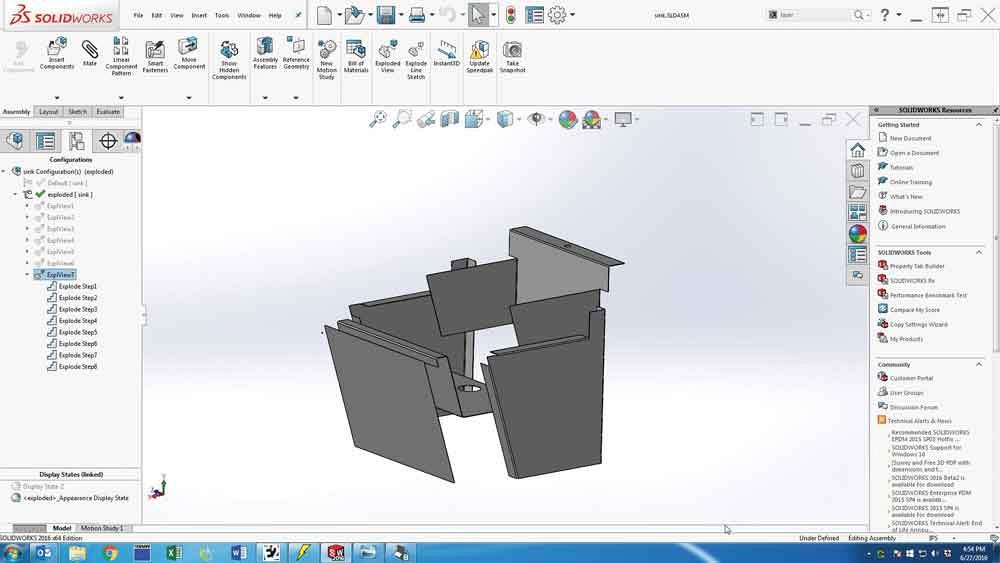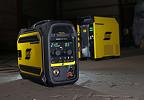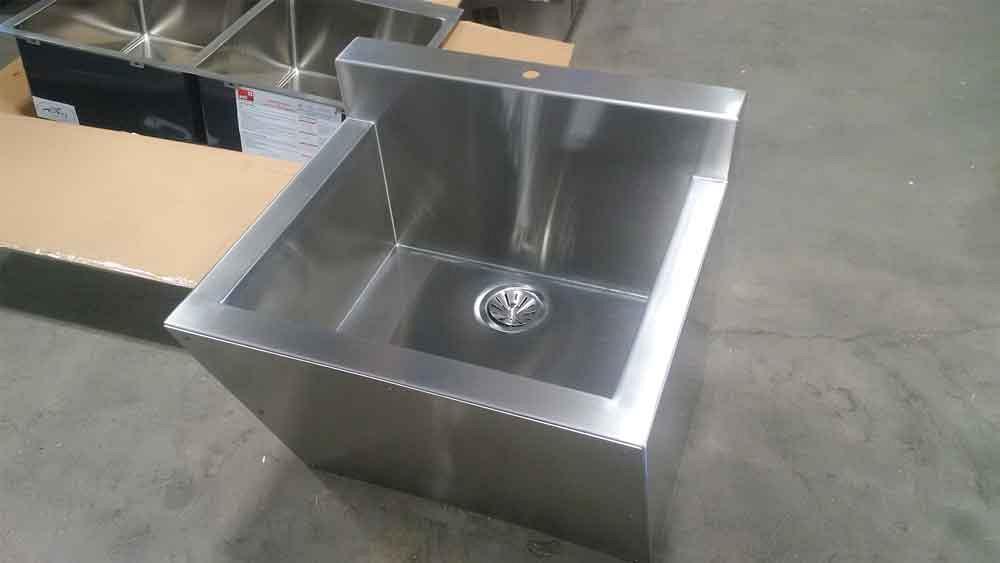Editor
- FMA
- The Fabricator
- FABTECH
- Canadian Metalworking
Pure Ingenuity adds to fabricating sophistication with 14-axis press brake
- By Rob Colman
- October 21, 2016
- Article
- Fabricating

Bending a long piece of sheet metal with the help of lifters on the LVD Strippit PPEB press brake at Pure Ingenuity.
Kingston, Ont.-based Pure Ingenuity™ designs and manufactures custom stainless steel and aluminum processing equipment and machinery for leading manufacturers in North America and around the globe. The company supplies a range of engineering disciplines and does much of its own welding, machining, metal forming and fabrication, electrical automation, and programming.
Like any fabricating shop, Pure Ingenuity is always looking for ways to increase productivity. Company President Richard Ward felt that this could best be accomplished in the shop’s bending operation. The only question was whether to invest in a panel bender or a more advanced CNC press brake. The two types of machines solve somewhat different challenges: A panel bender can produce standard shapes quite rapidly and with repeatability; an advanced CNC press brake can address the challenges posed by larger parts with novel bend requirements.
Ward eventually chose to invest in an LVD Strippit PPEB press brake. He says he has been impressed by how it has increased bending efficiencies and made certain types of jobs simpler to process.
Processing Know-how
Pure Ingenuity was founded in 1971 primarily as a fabricating shop performing many jobs, from ductwork to various stainless steel and galvanized steel products. Fairly early on in its history, the company began focusing on work for food processing companies because eastern Ontario had quite a large food processing footprint.
In 1986 Ward was hired as the first engineer in the company. From that point Pure Ingenuity started to steer toward more work that involved engineering design.
“Now we probably design 80 per cent of what we build and sell,” said Ward. “We often work with customers collaboratively. We bring to the table our knowledge of the manufacturability of designs, as well as a long history of working in the food and pharmaceutical processing industries.”
As Ward describes it, every food or pharmaceutical industry application shares certain processes, such as pumping, cleaning, mixing, and material handling.
“In each case, the equipment has to have the right surface finishes, has to be built using the correct materials, and has to use FDA-approved plastics,” Ward explained. “Having expertise in all of these requirements, and more, gives us our advantage. Beyond that, a lot of customization goes into creating systems for each client.”
Globalization and free trade have helped expand Pure Ingenuity’s reach over the years. Where once the company was designing products strictly for Canadian plants, its expertise made it possible for them to bid on and win projects around the world.
The company currently has five engineers and one student engineer on staff, 16 people in the shop, and a couple of support staff. The main shop is 12,800 sq. ft., and Ward added a second building to the company’s operation – 13,000 sq. ft. that includes space in which the team can test build equipment and a glass bead blasting booth for some finishing requirements.
Bend Flexibility
Pure Ingenuity is well-equipped for both fabricating and machining, with a CO2 laser; an older CNC press brake; angle roll, section roll, and plate rolling capabilities; a substantial welding area; mills; lathes; and a radial drill.
While the shop covers all of its own fabricating needs, some larger machining jobs are managed by other local shops.
Ward has had plans to add to the shop’s fabricating capabilities for a while now, understanding that some new technologies are ideal for simplifying some of the processes that the company does regularly.
“I went to CMTS in the fall of 2015 and ended up purchasing three machines,” Ward explained. “I initially went looking for a panel bender, then met the guys at Elliott Matsuura. They had the 14-axis LVD Strippit PPEB, and I saw that it was just a really fully equipped and productive machine.”
Asked why he was looking for a panel bender, Ward said, “Whenever I look at a machine I always want to get a new capability that my competitors don’t have. There are certain applications for panel benders that would be really useful for us. For instance, we do a lot of stainless steel cabinets and other jobs for which you can make doors and other parts quickly when you are bending material in both directions. A panel bender is great for that.”
But the 14-axis press brake Ward ended up purchasing had other capabilities that were equally attractive, if not more so.

A demonstration of how the CADMAN-B 3-D programming software unfolds a part to create a flat pattern.
“For instance, the press brake ram can tilt so that you can do taper bending,” Ward explained. “We do a lot of oddly shaped parts, and I didn’t realize how much time my operators were spending using our older CNC brake making sure the part was bent accurately.
“The brake also has a 6-axis backgauge, which allows for a lot more gauging possibilities,” he continued. “That is where you get repeatability, with really accurate gauging. Any parts where you have a staggered bend, where you might be bending one end of a part and not the other, you can keep the two gauges at different depths or heights. Or, if you are starting with a flat blank to produce a cone, you have to step that around and your backgauges can move to keep that in place. Previously we couldn’t do that. For any cone bending we’d have to mark out all of the bends at both ends and then manually feed those through and the operator would be eyeballing it. We came to think that it takes half an hour to bend each side of a cone. Now we can do it in about five minutes. So we’ve gained efficiencies and a lot of new capabilities.”
Pure Ingenuity’s brake is equipped with CNC sheet followers as well, so that panels that used to require two or three people to bend them properly can be managed by just one person.
“This also helps with bending a long cone,” said Ward. “When bending a long cone using our old press brake, you’d need two people to line up the marks at the two edges of the part as you stepped it through. And if you were doing several parts, you’d never get two that were precisely the same. Now we can have one person do that in a fraction of the time. There’s a little more time spent in programming, but that’s all.”
The brake is equipped with LVD Strippit’s Easy-Form® Laser adaptive bending system, which Ward said “ensures that we get parts that are bang-on accurate pretty much right away.”
Software and Control Reduce Development Time
Ward is proud of the fact that he has very talented press brake operators. He considers this type of technology a real benefit to them.
“That skill is still important because sometimes measurements have to be adjusted, but this takes a lot of the development time out of a project,” he said. “This machine allows us to take a solid model and feed it to the system’s CADMAN®-B 3D programming software. It has its tooling in a database and is able to unfold that part and create a flat pattern that can then be sent to our laser, and so forth. We do offline programming so we can draw a model, simulate the bending to test it, and then send it to be cut on the laser. Once it gets to the press brake, the operator merely has to follow the image on the Touch-B CNC to understand the bends to be made.”
The brake is also equipped with hydraulic clamping, and the brake’s software explains exactly where tooling needs to be placed for a particular job.
“Another thing that has been helpful is that it is equipped to read bar codes, so we can send a traveler down to the machine, it can be scanned, and the part comes up on-screen and prompts the operator about what tooling needs to be put in the machine,” Ward said. “The great thing about having the press brake set up as part of our main computer network is that if the operator makes a tweak to a part, the software updates the program so that that change will be made not only in that program on the machine, but it will be stored in our server. The next time someone goes to make that part, it has been updated on the server. This is important for parts that may have flanges that are too short to use the Easy-Form Laser to control the bend. In that case, you’re doing air bending and you’re pulling the data from the machine’s database, so previously determined angle corrections are applied, giving accurate bends.”
Pure Ingenuity uses barcoded travelers to track all of its jobs. Whenever someone in the shop does a job, they scan a bar code on the traveler to log them onto the job and record their time.
The finish on parts is obviously critical for food processing equipment. The dies for the press brake are designed with a unique STONE® compound die radius that reduces the risk of scratching stainless steel.
Ward said that he has plans for more changes to help the company maintain its market reach and fabricating strength. Watch for updates in future issues of Canadian Fabricating & Welding.
Editor Robert Colman can be reached at rcolman@canadianfabweld.com.
About the Author

Rob Colman
1154 Warden Avenue
Toronto, M1R 0A1 Canada
905-235-0471
Robert Colman has worked as a writer and editor for more than 25 years, covering the needs of a variety of trades. He has been dedicated to the metalworking industry for the past 13 years, serving as editor for Metalworking Production & Purchasing (MP&P) and, since January 2016, the editor of Canadian Fabricating & Welding. He graduated with a B.A. degree from McGill University and a Master’s degree from UBC.
subscribe now


Keep up to date with the latest news, events, and technology for all things metal from our pair of monthly magazines written specifically for Canadian manufacturers!
Start Your Free Subscription- Trending Articles
CWB Group launches full-cycle assessment and training program

Achieving success with mechanized plasma cutting

3D laser tube cutting system available in 3, 4, or 5 kW

Brushless copper tubing cutter adjusts to ODs up to 2-1/8 in.

Welding system features four advanced MIG/MAG WeldModes

- Industry Events
MME Winnipeg
- April 30, 2024
- Winnipeg, ON Canada
CTMA Economic Uncertainty: Helping You Navigate Windsor Seminar
- April 30, 2024
- Windsor, ON Canada
CTMA Economic Uncertainty: Helping You Navigate Kitchener Seminar
- May 2, 2024
- Kitchener, ON Canada
Automate 2024
- May 6 - 9, 2024
- Chicago, IL
ANCA Open House
- May 7 - 8, 2024
- Wixom, MI
















